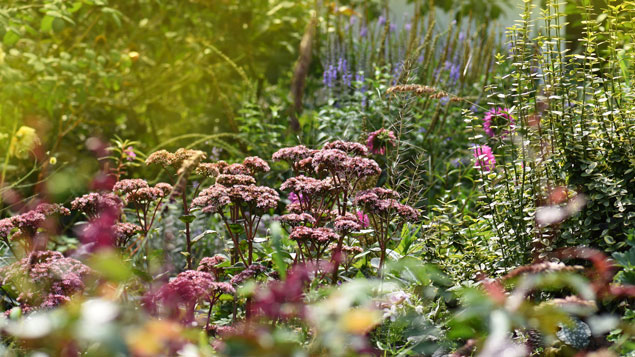Whether you have an elaborate kitchen garden or a small patch for raising veggies, things will start to slow down in the fall. Check off these chores to prepare for next season.
CARE FOR YOUR VEGETABLE GARDEN
• Clean out beds. Removing all plant debris helps prevent pests and diseases from overwintering in your garden and returning even worse in spring.
• Put away stakes, labels and other accessories. As you remove plants, don’t forget to gather items such as labels, stakes and cages. Store them where they’ll be handy to reuse next year.
• Add compost. Spread a 2- to 3-inch-thick layer of compost over your beds to enrich the soil. There’s no need to till it in; precipitation and soil organisms will do the job for you.
• Plant cover crops. Sow cover crops like mustard, peas or clover in the fall to prevent erosion. Then turn them over into the soil in spring to add nutrients.
• Expand planting areas. If you’d like to increase your planting space, fall is an excellent time to set up new raised beds or start a lasagna garden where you want to smother grass for an in-ground bed.
CARE FOR TREES AND SHRUBS
Did you know fall is an excellent time for planting trees and shrubs? This is when you should start that new hedge or establish a new shade tree in your yard because the soil is still warm enough for roots to grow a little before winter. In addition, a little fall care for your established trees and shrubs will help them weather the colder months better.
Follow these steps:
• Plant new trees and shrubs. Add deciduous and evergreen trees and shrubs now.
• Provide plenty of water. Newly planted trees and shrubs — and established ones — will tolerate winter conditions better when well-watered in fall. Likewise, extra water for evergreens is essential in fall.
• Replenish mulch. Add a fresh layer of mulch, such as wood chips, pine straw or shredded leaves, around trees and shrubs to protect roots from winter temperatures. Keep mulch from touching the trunks to prevent rot and other diseases.
• Prune after dormancy starts. Trimming after August will trigger tender new growth that’s easily damaged in winter. Instead, wait to prune until leaves have fallen from deciduous species.
ORGANIZE YOUR TOOLS AND GARDENING GEAR
As the growing season winds down, don’t forget to prep your garden tools for winter.
• Clean hand tools. Remove dirt, then place the metal ends of garden trowels, weeders and other tools in a bucket of sand laced with vegetable oil.
• Sharpen blades. Pruners and loppers can get dull with lots of use, as can shovels and spades. And don’t forget mower blades. Use a file to restore their sharp edges, then coat with a bit of vegetable oil to prevent rust over the winter.
• Drain hoses and irrigation lines. Before freezing weather sets in, remove any water from your garden hoses and irrigation tubing.
• Prepare small engines. Drain gas lines of mowers, weed whackers and tillers. Change oil as needed before storing machines in dry, covered spaces for winter.
• Clean out sprayers. Empty and wash out your spraying equipment with soap and water inside and out. Rinse and allow them to air dry before stowing. If you have leftover chemicals, store them in a safe place where they won’t freeze.
CLEAN UP ANNUALS AND CONTAINERS
Colorful annuals often are the first plants to succumb to frosty fall weather. Once a hard frost does them in, you’ll want to tidy up planting beds and pots to be ready for next spring.
• Empty containers. The freeze-and-thaw cycle can crack containers, especially those made of clay left full of potting mix. After cleaning out your pots and planters, store them in a protected, dry area like a shed or garage. Pots too large to move easily may be wrapped in burlap or even bubble wrapped to help prevent cracking.
• Clean out flower beds. Once frost withers annual plants in your garden beds, it’s time to pull them up so your planting space will be ready for new flowers come spring.
• Collect and store seeds. You can save seeds of many kinds of popular annuals, such as celosia, petunia, cosmos and nasturtium. Place each type of seed in a labeled envelope and stash them in a cool, dry place until you can sow them in spring.
• Dig up tender bulbs. Cannas, dahlias, caladiums and other tropical bulbs and tubers will not survive winter freezes. Dig them up shortly after the foliage turns brown in fall and store them in a cool, dry place for planting outside next spring.
• Take cuttings to grow indoors. Snip sprigs of favorites, such as coleus, geraniums and sweet potato vine, before temperatures get below 50 degrees Fahrenheit. They’ll root easily in water, providing a little indoor winter color. You can even keep them going long enough to plant outside again in spring.



